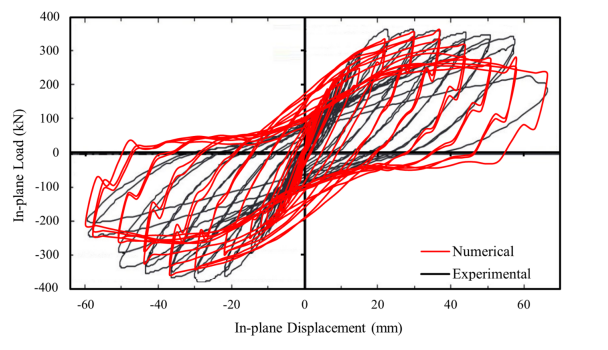Muhammad Umer Farooq, Bowen Zeng, and Yong Li
i Graduate Student, University of Alberta, Edmonton, Canada, yong9@ualberta.ca
ii Post-doctoral Fellow, University of Alberta, Edmonton, Canada, bzeng1@ualberta.ca
iii Associate Professor, University of Alberta, Edmonton, Canada, yong9@ualberta.ca
ABSTRACT
In conventional masonry construction, the use of grout significantly increases construction costs and time due to the additional material, labour, and curing processes required. This numerical study aims to identify alternatives to conventional fully grouted reinforced masonry (FGRM) walls that use less or no grouting, without bonding the vertical reinforcement. To demonstrate this, the effect of grout and bonding, on the in-plane (IP) behaviour of masonry walls was studied. A total of 20 walls were analysed which were categorized into five groups. In addition, to capture different failure modes (e.g., flexural, shear), four different aspect ratios i.e., 2, 1.44, 1 and 0.86 were considered. The numerical simulations were conducted in the general-purpose finite element software ABAQUS using the simplified micro modelling strategy, in which the individual components (e.g., concrete block, grout, reinforcements) were explicitly represented. The results indicated that when compared with URM masonry, un-grouted RM walls have higher strength and ductility. However, the un-grouted walls with unbonded reinforcement exhibit complex failure patterns and relatively lower in-plane capacities than conventional FGRM walls due to the absence of grout. It was also observed that the grouted unbonded masonry walls with a smaller aspect ratio are inherently stable with maximum loads comparable to those of conventional bonded RM walls. Based on the above numerical modelling and analyses, it is concluded that the use of unbonded reinforcement would save construction time and labour costs, particularly when constructing non-slender masonry walls.
KEYWORDS: Masonry Construction, Un-grouted Masonry, Unbonded Reinforcement, In-Plane Behaviour, Numerical Modelling.
113-Farooq.pdf



